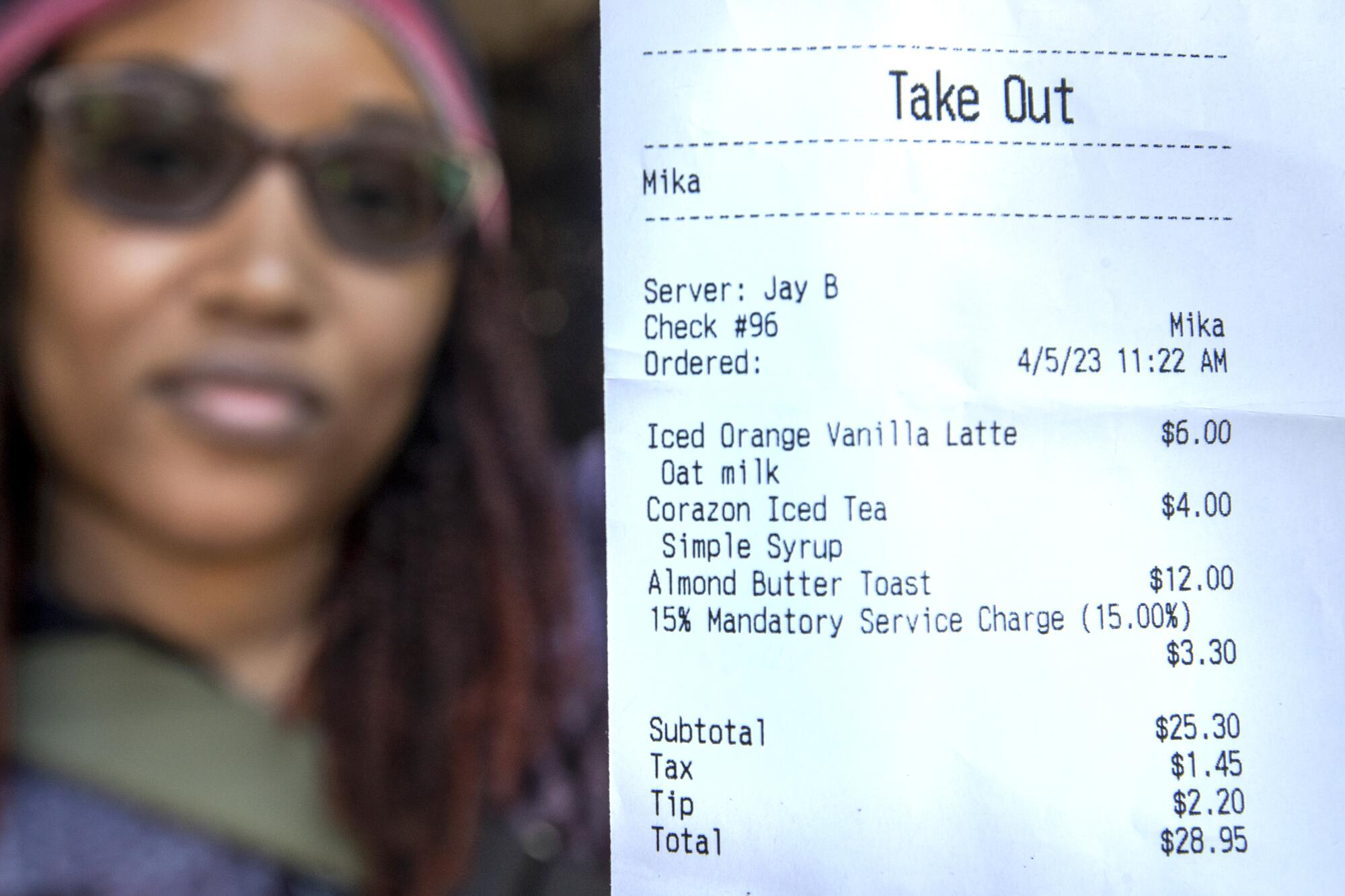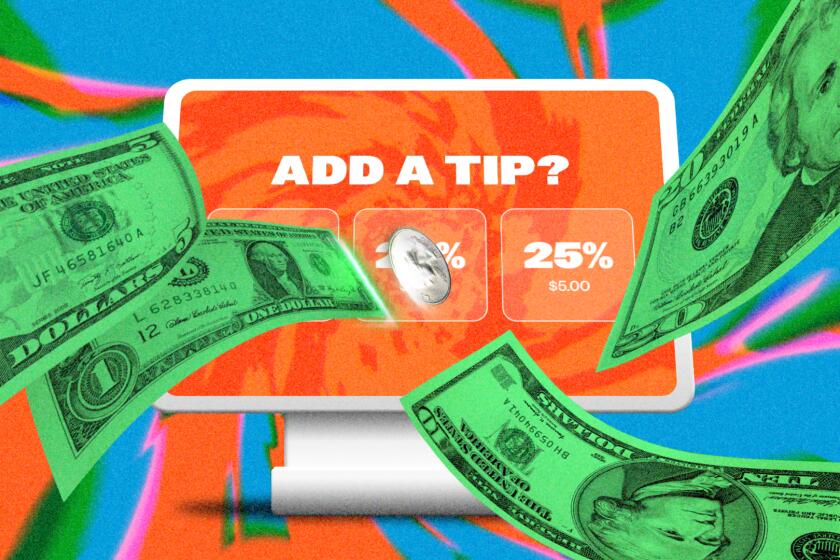
A class-action lawsuit was filed in Los Angeles Superior Court on June 20 by former servers at Jon & Vinny’s, a hip Italian American restaurant owned by Jon Shook and Vinny Dotolo, with locations in Fairfax, Beverly Hills and View Park-Windsor Hills. The lawsuit against Joint Venture Restaurant Group Inc., which owns Jon & Vinny’s, claims that the company denied servers tips, resulting in a reduction of take-home pay due to diner confusion regarding an 18% service fee.
After The Times published an article by Food staff reporter Cindy Carcamo detailing the lawsuit, more than 100 readers responded to a call-out weighing in on tipping and service fees that are becoming commonplace at L.A. restaurants. Here’s what they had to say. (Answers have been edited for length and clarity.)
The restaurant says the 18% service fee attached to checks is part of a vision to make pay more equitable among all workers. The suit filed Tuesday in L.A. seeks damages for what servers claim are tips.
“Service fees (like hospitality or convenience fees) are so deceiving and disgusting. All employees should get a fair wage, and that should be figured into the price the customer has to pay. In my home country of Germany, customers always pay the price on the menu. Tips, taxes and all other fees are always included. So one knows exactly what to expect — and so do the employees.”
— Peter M. Graf
“Restaurant owners should pay employees minimum wage, and service charges should be treated like a tip pool with different points given to different positions, for all hourly employees (front of house and back of house) working a particular night. So if you worked on a Friday night, all the service charge money from [that] night would go to the staff working on [that] night — just like a tip pool. It should not go to managerial staff or people buying produce at the farmers market, employee wages, maintenance or any other expenses. Customers should be allowed to tip on top of that if they want, and that would be distributed the same way as the service charge. In summary, minimum wage + service charge (pool) + additional tip (pool).”
— Adham Taman
“I feel that the ‘service charge’ is deceptive. These restaurant owners should include the cost of doing business in the pricing on the menu. Why do I need to additionally subsidize their operating cost in this manner? I don’t buy their explanation as to why they do this. In the future, I will not patronize restaurants that resort to this. I don’t like the practice of splitting tips either, but if that’s what the employer and the employees agree to, at least it’s transparent and aboveboard.”
— Mark Tulowitzky
The norms around whom, and how much, Americans tip have shifted in recent years — and consumers are increasingly confused.
“We ate at the Beverly Hills location, and when we looked at the check, we discussed whether the 18% ‘service fee’ was the equivalent of a tip. We decided that it must be going to our waiter and did not add a separate tip, but something about it bothered me so as we were leaving I approached our waiter and asked if that service went to him. He said they receive $2 an hour from it. So I went back to the table and added a cash tip. The waiter thanked me for asking. Currently, there is no language regarding the 18% on the bill. It’s likely that we aren’t alone in thinking that because of the service fee, no tip is required.
“I agree with the idea that all those involved in the experience should be compensated, not just the waiters. But given that the restaurant is not sharing exactly where the 18% is going, it’s possible that it is simply more profit for the owners, in addition to providing them the opportunity to pay their staffs. As a consumer, new fees are being introduced everywhere without any explanation. And in virtually every transaction, there is now a moment where a worker asks for a tip. So either employers are not sharing revenues or the hourly wages are too low.”
— Jon & Vinny’s customer
“Oftentimes as a server, I was the last employee there. Kitchen closes, they clean and leave. Even the dishwasher. I still have to stay and wait for my tables and do side work, many times off the clock. The back of the house [workers] are guaranteed set hours. As servers, we don’t know if we are working an hour and being sent home or a full shift. I made excellent money in tips because I hustled. But that meant I was the last one there. Because times have changed, owners should just include wages to be reflected in menu prices. No B.S. fees. Just PAY your employees.”
— Janelle Delgado
The L.A. city attorney is looking into a hospitality group that runs some of the trendiest restaurants in Hollywood over healthcare service fees tacked on to diners’ bills.
“As a customer, I’ve always felt that if I can afford to dine out, I can afford to tip my server. As small service charges started showing up on my bills, I gladly paid them in addition to my tip, believing these charges were going to provide benefits such as health insurance that low-wage restaurant workers would otherwise not receive. When I have seen an 18% service charge added to the bill, I have always believed it was a suggested amount to tip, but I was free to leave an additional amount, which I rarely did. I understand the concept of pooling tips and I believe which employees receive how much of the tip I leave is a matter between the restaurant and the employees. I am not at all familiar with the model that Jon & Vinny’s is using, and as a diner, it would make it difficult for me to understand what a meal would cost before I chose to go there. I do support the concept of all employees receiving a livable wage but would be more likely to avoid rather than support Jon & Vinny’s restaurants, based on this dispute with their employees.”
— Mark Brown
“I strongly believe that all tips should be shared across all front of house and back of house staff (excluding management) and applaud restaurants that do that. However, for that model to be successful, a clear, consistent and transparent message needs to be shared and understood by all customers and staff. As a customer, I love when gratuity is included and I’m given the explanation that it’s going to all staff members.
Tipping and restaurant pay structures are direct legacies to slavery. The pay inequities between front and back of house often fall along racial lines, with white people working higher-paid front of house positions and people of color working lower-paid positions. Tipping perpetuates this. And when POC are in customer-facing positions, studies show they receive fewer tips. Working toward a restaurant industry that is not reliant on tips, and instead has the true cost of livable wages reflected in food prices, offers a solution. But it’s not going to be solved by one-off restaurants changing and instead requires a large systems shift.”
— Megan Meo
Camryn Brewer and Amy Wong contributed to this story.
The norms around whom, and how much, Americans tip have shifted in recent years — and consumers are increasingly confused.
More to Read
Eat your way across L.A.
Get our weekly Tasting Notes newsletter for reviews, news and more.
You may occasionally receive promotional content from the Los Angeles Times.














